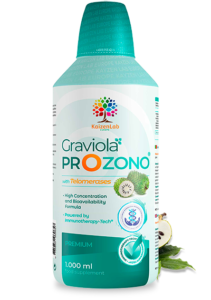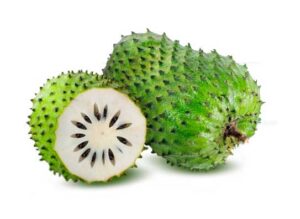Graviola Prozono
Registered Scientific Literature, Composition, Ingredients and Studies
properties
Annona muricata (graviola) contains phytochemical substances that are effective in the treatment of malignant neoplasms, which together are called Annonaceous acetogenins (AGEs), capable of inducing selective cytoxicity on cancer cells, by inhibiting the production of high amounts of ATP adenosine triphosphate), compared to normal cells, which leads to a limitation of the growth capacity of anarchic cells1. Several “in vitro” and in vivo “studies show its activity in relation to tumors of the breast, liver, prostate, pancreas, colon and lung.
Annona muricata also showed inhibitory activity in leukemia, lymphoma and adenocarcinoma. Its immunomodulatory and antioxidant effects , should also contribute to the control of the processes leading to neoplasms.
The Pau D’arco also nicknamed Ipé-purple, with the Latin designation of unbeatable Tabebuia, and other genres of tavern, such as Avellanedae, has a high content of lapachol, a naphthoquinone.
Lapachol inhibits glycolysis in malignant tumor cells by intervention at the level of the enzyme pyruvate kinase M2, with a significant decrease in ATP levels and consequent inhibition of cell proliferation, and promotion of apoptosis.
Carnosine is a dipeptide (beta-alanyl-l-histine) that has varied physiological effects, capable of exerting anti-tumor effects.
Inhibitory activity of glycation processes (leading to degenerative processes); (For example, in the case of stem cells, in normal cells and in the inhibition of this protection at the level of tumor cells, with reduction of ERK (extracellular signal regulatory kinase), kinase is responsible for survival and cell proliferation. Its reduction activity in telometers shortening processes, with consequent protection of DNA (deoxyribonucleic acid), determines gene dysfunctionality and consequent degenerative processes.
The vast majority of tumor cells have a metabolism characterized by a state of hypoxia. Hypoxia is revealed adverse to the effects of radiotherapy and chemotherapy. Oxygen-induced tumor oxygenation allows these two conventional treatments to be more effective. In addition to the intense reduction of hypoxia at the level of neoplastic cells, it reduces the resistance of these cells to apoptosis processes, and the capacity for tumor angiogenesis, with a significant decrease in the aggressiveness potential of the tumor.

Composition
- Graviola (Annona muricata) – fruit (dry ext. 5: 1): 600 mg
- Pau D’arco (Tabebuia avellanedae) – husk (ext. Dry 5: 1): 200 mg
- Olea europaea oil with fixed ozone1: 200 mg
- Beta-alanine (amino acid): 200 mg
- Carnosine (dipeptide): 100 mg
- OZONE <> 30MG
Ingredients
- Purified water; soursop; Pau D’arco; olive oil – Olea europaea; Beta-alanine;
- Antioxidants: (L-ascorbic acid and ascorbyl palmitate);
- Stabilizer: (Gum Xantana);
carnosine; - Preservatives: (Potassium Sorbate and Sodium Benzoate); Aroma identical to the natural;
- Sweetener: (Stevia).
Scientific References
1- Potential benefits of Annona muricata against combat cancer: The review. Yajid AI, Ab Rahman HS, Kai Wong MP, Wan Zain WZ.
And in the case of women. 25 (1): 5-15.
2- Annona muricata: Is it the natural therapy for disease diseases including growth cancer in our backyard?
Review of your research history and future prospects. Ganasukulya Y, Wamunyokoli F, El-Shemy HA.
3- Lapachol and its derivatives potential drugs for cancer treatments. . Nepomuceno JL.
In: Plants and Crop the Biology and Biotechnology research – Edition 1o; Publisher: iConcept Press Ltd; pp.19
4- Demonstration of the lapachol to the potential of the metastatic cancer drug.
5- Lapachol inhibits glycolisis in cancer cells by targeting pyruvate kinase M2. Shankar Babu S, Lakhter AJ, Paul S, Naidu SR.
Plos One. 2018 Feb 2; 13 (2): e0191419.
6- Carnosine and cancer: The perspective. Gaunitz F, Hipkiss AR.
Amino Acids 2012; 43 (1): 135-142.
7- L-Carnosine that covers the telomere of damage and speed reduction in normal fibroblasts. Shao L, Li QH, Tan Z.
Biochem Biophys Res Common. 2004 Nov 12; 324 (2): 931-6.
8- Carnosine a natural antioxidant and geroprotective: from molecularism to clinical trials. Boldyrev AA, Stvolinsky S, Fedorova TN, Suslina Z. Research. 2010. 13 (2-3); 156.8.
9- Ozone therapy for tumor oxygenation: A pilot study.
Clavo B, Pérez JL. López L, Suárez G, Lloret M, Rodríguez V, Macias D, Santan M, Hernández MA, Martin-Oliva R, Robaina F.
Complementary Evidence Alternat Med. 2004 Jun; 1 (1): 93-98.
